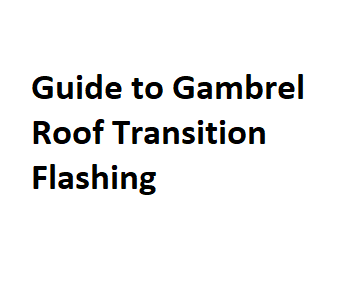When it comes to roofing, the gambrel style has a distinct and classic appeal. Its unique design, reminiscent of traditional barns and colonial homes, adds character to any structure. However, roofing transitions, especially in areas where different roof pitches meet, require careful attention to prevent leaks and ensure longevity. In this blog post, we’ll delve into the world of gambrel roof transition flashing, exploring its importance, installation techniques, and the key considerations for a successful roofing project.
Understanding Gambrel Roofs:
Before diving into the specifics of transition flashing, let’s briefly recap what makes gambrel roofs special. Gambrel roofs are characterized by their two slopes on each side, with the lower slope steeper than the upper one. This design not only enhances aesthetic appeal but also allows for more space in the attic, making it a practical choice for those seeking extra storage or living space.
The Challenge of Transition Areas:
The transition areas of gambrel roofs, where different roof pitches intersect, pose a challenge for effective water drainage. If not addressed properly, these areas can become susceptible to leaks, leading to potential damage to the underlying structure. This is where gambrel roof transition flashing plays a crucial role.
Importance of Transition Flashing:
Transition flashing serves as a protective barrier against water infiltration at the intersections of varying roof pitches. Its primary purpose is to direct water away from vulnerable areas, ensuring a watertight seal. Without proper flashing, rainwater, snowmelt, and debris may find their way into the crevices, leading to moisture damage, rot, and mold growth.
Installation Techniques:
Installing gambrel roof transition flashing requires careful planning and precision. Here are key steps to ensure a successful installation:
- Measurements and Materials:
- Accurate measurements of the transition areas are essential.
- Choose high-quality flashing materials, such as galvanized steel or aluminum, to ensure durability.
- Underlayment:
- Apply a waterproof underlayment beneath the flashing to provide an additional layer of protection.
- Flashing Placement:
- Install step flashing along the roofline, ensuring each piece overlaps the previous one to create a continuous water barrier.
- Sealing Joints:
- Seal joints and seams with a waterproof sealant or roofing cement to enhance water resistance.
Considerations for a Successful Project:
- Professional Assistance:
- If you’re not experienced in roofing projects, consider seeking professional assistance to ensure proper installation.
- Regular Inspections:
- Schedule regular inspections to identify and address any potential issues before they escalate.
- Maintenance:
- Keep the roof and flashing clean of debris, as accumulated leaves and branches can compromise the effectiveness of the flashing.
- Climate Considerations:
- Take into account the climate of your region when choosing flashing materials. Some materials may be better suited to withstand extreme weather conditions.
- Ventilation:
- Ensure proper ventilation in the attic space to prevent the accumulation of moisture, which can compromise the effectiveness of the flashing.
- Aesthetics:
- While functionality is paramount, consider the aesthetics of the flashing. Well-designed flashing can seamlessly blend with the overall architecture, enhancing the visual appeal of your gambrel roof.
- Local Building Codes:
- Familiarize yourself with local building codes and regulations related to roofing. Compliance with these codes is essential to ensure the safety and structural integrity of your roof.
- Quality Flashing Products:
- Invest in high-quality flashing products from reputable manufacturers. Quality materials contribute significantly to the longevity and performance of your roofing system.
- Educate Yourself:
- Take the time to educate yourself about gambrel roofs and transition flashing. Understanding the intricacies of your roofing system will empower you to make informed decisions and communicate effectively with roofing professionals.
- Emergency Preparedness:
- Have an emergency plan in place in case of unexpected leaks or damage. Quick response to potential issues can mitigate the extent of damage and protect your home from further harm.
Case Study: Successful Gambrel Roof Transition Flashing Installation
To better illustrate the importance of gambrel roof transition flashing, let’s explore a hypothetical case study of a homeowner who successfully navigated the challenges of transitioning roof pitches.
Background: The Johnsons, a family residing in a historic colonial-style home, decided to renovate their attic space to create an additional bedroom. Their home featured a beautiful gambrel roof, and they were keen on preserving its aesthetic while ensuring the structural integrity of the new living space.
Challenges: Given the gambrel roof’s unique design, the transition areas were critical points of concern. The Johnsons were aware that without proper transition flashing, the new living space could be vulnerable to leaks and water damage.
Steps Taken:
- Consultation with a Professional:
- The Johnsons consulted with a roofing professional experienced in working with gambrel roofs. The professional conducted a thorough assessment of the transition areas and recommended specific flashing materials and installation techniques.
- Quality Materials:
- Following the professional’s advice, the Johnsons invested in high-quality galvanized steel flashing. The material was not only durable but also resistant to corrosion, ensuring a longer lifespan for the flashing.
- Accurate Measurements:
- Precise measurements were taken to custom-fit the flashing to the unique angles and pitches of the gambrel roof. This step was crucial to creating a seamless and effective transition barrier.
- Proper Installation:
- The roofing professional meticulously installed step flashing along the roofline, ensuring each piece was correctly overlapped to create a continuous water barrier. Joints and seams were sealed with a waterproof sealant to enhance water resistance.
Results: The Johnsons’ careful planning and investment in proper gambrel roof transition flashing paid off. The new bedroom in the attic remained dry and free from leaks, even during heavy rainstorms. The family could enjoy their renovated space without the worry of water damage.
Types of Gambrel Roof Transition Flashing
| Flashing Type |
Material |
Purpose |
Installation Method |
Recommended Sealant |
| Step Flashing |
Aluminum |
Seals roof-wall junctions |
Insert under shingles |
Roofing sealant |
| Counter Flashing |
Copper |
Covers top of step flashing |
Secure with screws |
Waterproof sealant |
| Kickout Flashing |
Galvanized Steel |
Redirects water into gutters |
Install at roof edges |
Butyl rubber sealant |
| Valley Flashing |
Stainless Steel |
Guides water down roof valleys |
Lay under roofing material |
Roofing cement |
| Apron Flashing |
Lead |
Covers horizontal joints |
Attach with roofing nails |
Lead caulking |
Key Components of Gambrel Roof Transition Flashing
| Component |
Description |
Function |
Material |
Installation Method |
| Flashing Tape |
Flexible, self-adhesive |
Seals joints and seams |
Butyl rubber |
Peel-and-stick |
| Counter Flashing Cap |
L-shaped profile |
Covers step flashing top |
Aluminum |
Secure with screws |
| Roofing Apron |
Thin, extended piece |
Covers horizontal joints |
Copper |
Nail in place |
| Drip Edge |
Angled metal strip |
Directs water into gutters |
Galvanized Steel |
Nail along roof edge |
| Valley Diverter |
Zigzag-shaped piece |
Directs water along valleys |
Stainless Steel |
Install under roofing |
Common Installation Mistakes and Solutions
| Mistake |
Description |
Solution |
Prevention |
Additional Notes |
| Improper Sealant Use |
Using incompatible sealant |
Choose appropriate sealant |
Check sealant compatibility |
Follow manufacturer guidelines |
| Inadequate Overlapping |
Flashing pieces not overlapping sufficiently |
Increase overlap length |
Measure and mark overlaps |
Use proper flashing size |
| Incorrect Angles |
Flashing not angled correctly |
Ensure proper angle during installation |
Use a protractor |
Double-check angle measurements |
| Poor Fastening |
Insecure attachment of flashing |
Use appropriate fasteners |
Follow manufacturer recommendations |
Inspect and reinforce if necessary |
| Neglecting Inspection |
Lack of regular inspection |
Schedule routine inspections |
Set a maintenance calendar |
Address issues promptly |
Recommended Tools for Gambrel Roof Transition Flashing Installation
| Tool |
Purpose |
Description |
Safety Considerations |
Additional Tips |
| Flashing Bender |
Bends metal flashing |
Manual or powered |
Wear gloves and eye protection |
Practice on scrap material first |
| Roofing Nailer |
Secures flashing in place |
Pneumatic or manual |
Follow proper nailing techniques |
Adjust air pressure as needed |
| Caulk Gun |
Applies sealant |
Manual or battery-powered |
Use proper caulk for the material |
Keep a rag for quick cleanup |
| Tin Snips |
Cuts flashing material |
Straight, left, and right-cut options |
Wear gloves and eye protection |
Replace blades as needed |
| Roofing Hammer |
Drives nails securely |
Smooth face to avoid damaging flashing |
Grip hammer correctly for control |
Choose appropriate hammer weight |
Gambrel Roof Transition Flashing Maintenance Checklist
| Task |
Frequency |
Description |
Tools Needed |
Notes |
| Inspect Seals |
Annually |
Check sealant for cracks or gaps |
Flashing Bender, Caulk Gun |
Replace or reseal as necessary |
| Clean Gutters |
Biannually |
Remove debris from gutters |
Roofing Nailer, Drip Edge |
Ensure proper water drainage |
| Check Flashing Condition |
Quarterly |
Inspect for rust, damage, or misalignment |
Tin Snips, Roofing Hammer |
Replace damaged flashing promptly |
| Clear Debris on Roof |
After storms |
Remove branches, leaves, or other debris |
Roofing Nailer, Caulk Gun |
Prevent water pooling and damage |
| Evaluate Overlaps |
Biannually |
Ensure proper overlap of flashing pieces |
Flashing Bender, Tin Snips |
Adjust overlaps if needed |
Conclusion:
This case study highlights the importance of proactive planning and professional guidance when dealing with gambrel roofs and transition flashing. By taking the necessary steps to understand the unique challenges posed by varying roof pitches and investing in quality materials and installation, homeowners can successfully protect their homes and enjoy the timeless beauty of gambrel roofs.
In conclusion, whether you’re embarking on a new construction project or renovating an existing gambrel-roofed home, giving due attention to transition flashing is a wise investment. It not only safeguards your property from potential water damage but also ensures that your home’s distinctive architectural features stand the test of time.


